22 Mind-Blowing Stadiums Built on or Near the Water
Stadiums have long been more than just places to watch a game—they're grand stages where human achievement meets architectural innovation. But some venues go even further, turning the very landscapes they occupy into part of the spectacle. Nowhere is that more true than with stadiums built alongside, above, or seemingly within the water. These waterfront wonders blur the line between engineering and art, rising dramatically from coastlines, nestled along tranquil rivers, or floating like futuristic dreams upon lakes and harbors. In these stunning locations, the roar of the crowd is matched only by the crash of waves or the shimmer of sunlit reflections. Whether you're catching a football match with a sea breeze in your face or attending a concert as boats drift by in the distance, the experience becomes something unforgettable. Originally a collection of 12 breathtaking examples, we’ve now expanded our list to 22 incredible waterfront stadiums around the world that truly redefine what’s possible when sport, design, and nature come together. From floating fields to arenas with panoramic ocean views, each one proves that location really is everything.
1. Marina Bay Floating Stadium – Singapore
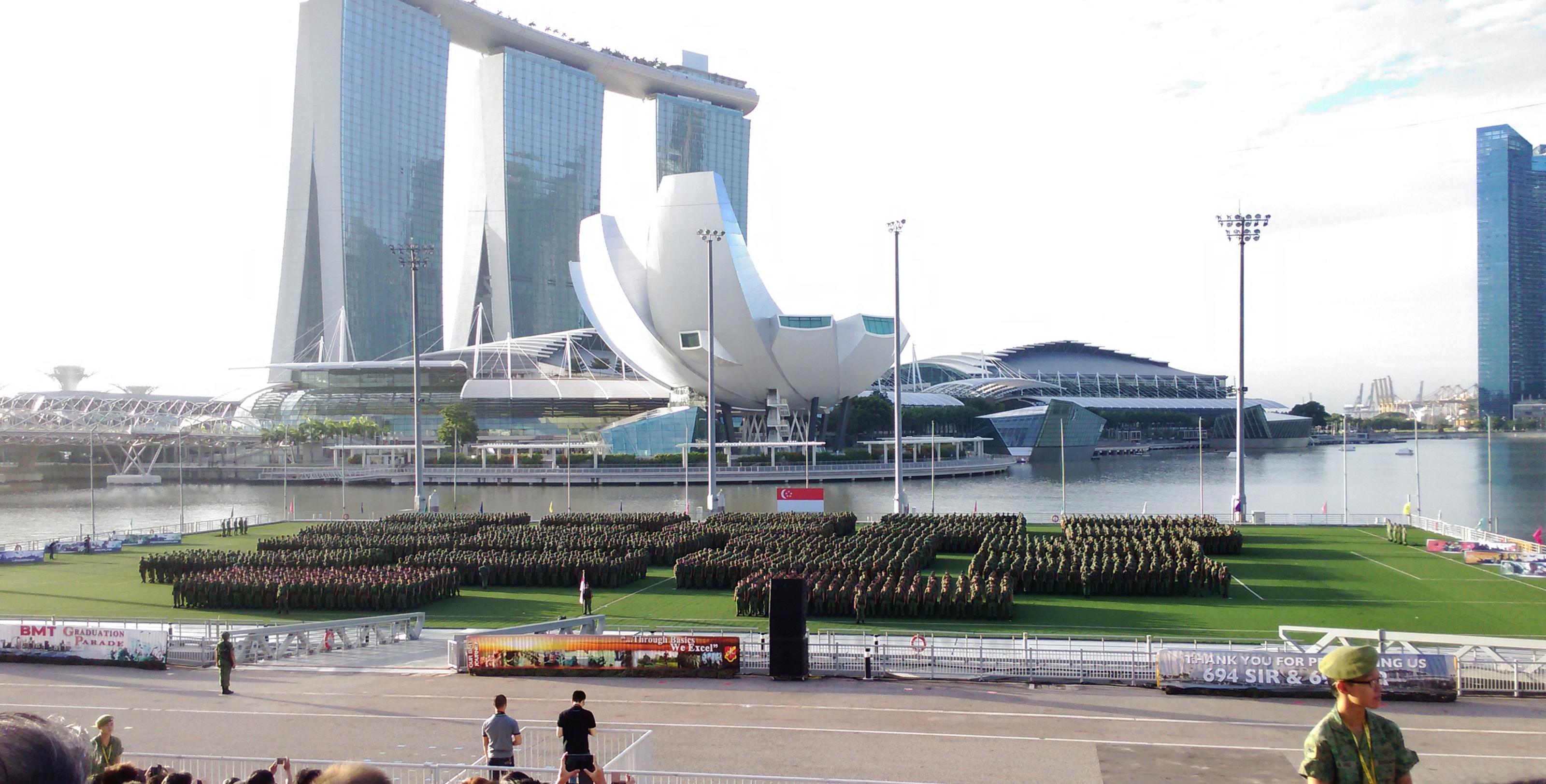
Singapore’s Marina Bay Floating Stadium is truly one of a kind—it's the world’s largest floating football field, built entirely on water. This futuristic stadium, resting on a platform in Marina Bay, can support up to 9,000 people on the floating stage itself, while its seating is located on the shore, accommodating over 30,000 spectators. The skyline backdrop of Singapore’s towering skyscrapers makes it one of the most visually striking stadiums on the planet. It's used for major national events, concerts, and even the Singapore Grand Prix festivities.
2. Estadi Nacional – Andorra
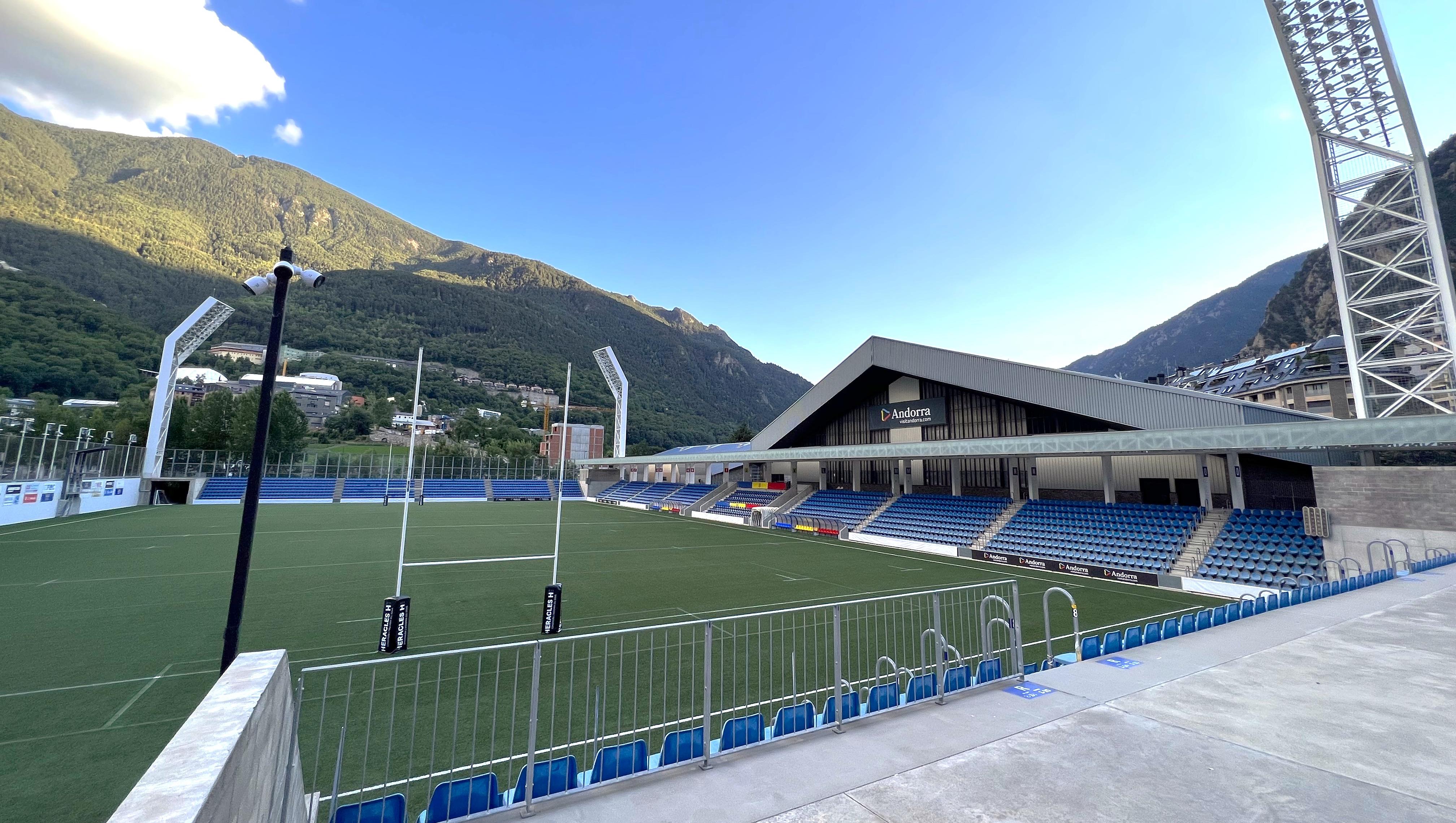
Andorra’s national stadium, Estadi Nacional, sits in a breathtaking valley surrounded by the Pyrenees Mountains, with a pristine river flowing nearby. While not floating, the stadium’s proximity to the water and stunning alpine backdrop creates an incredible setting for football matches. It’s the home of Andorra’s national team, bringing an intimate yet scenic experience to every game.
3. Avicii Arena – Sweden
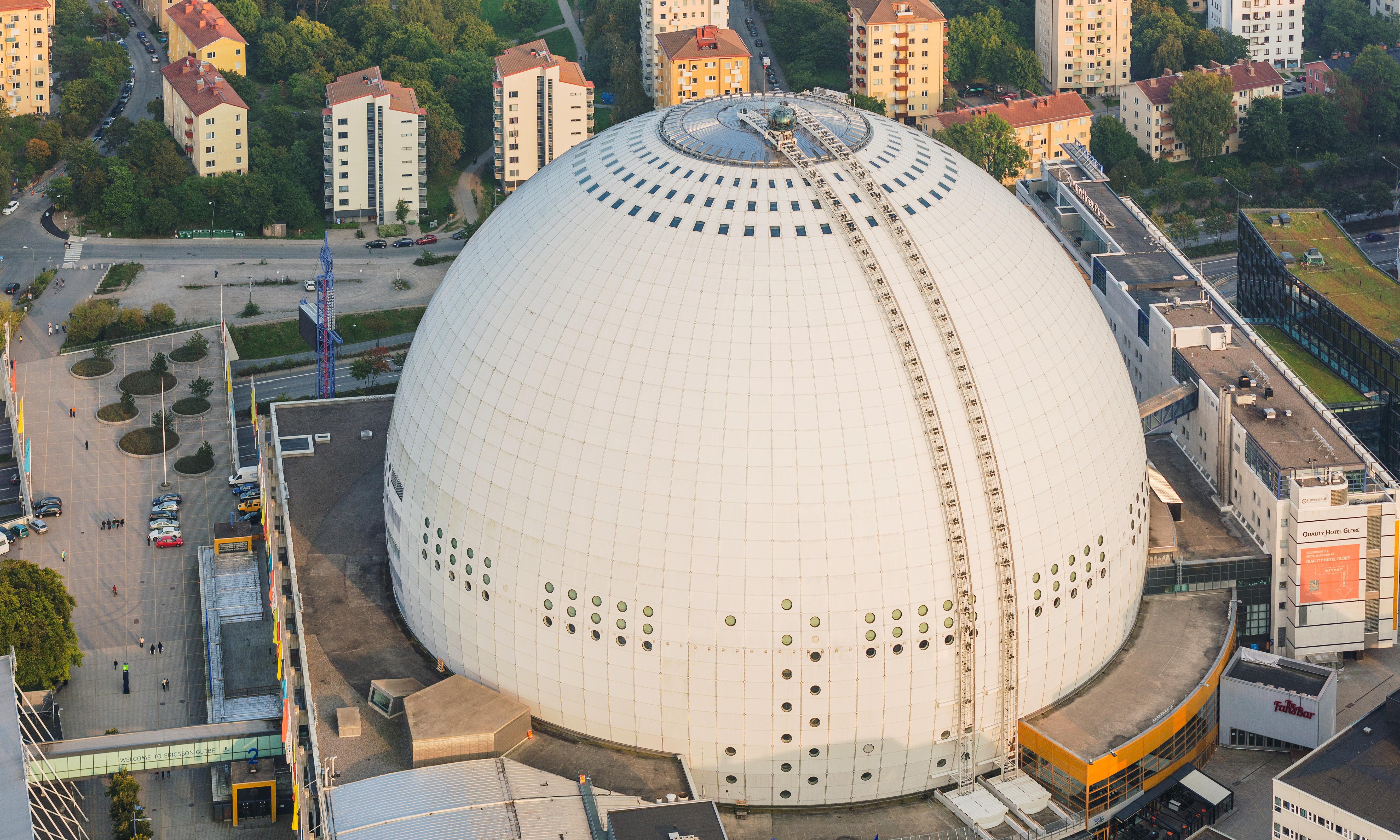
Stockholm’s Avicii Arena, formerly known as the Ericsson Globe, is one of the most unique stadiums in the world. Located next to the water, this perfectly spherical venue is the largest hemispherical building on Earth. It hosts hockey, concerts, and esports events, with its glass-clad, futuristic exterior reflecting the surrounding waterfront beautifully.
4. Arena da Amazônia – Brazil
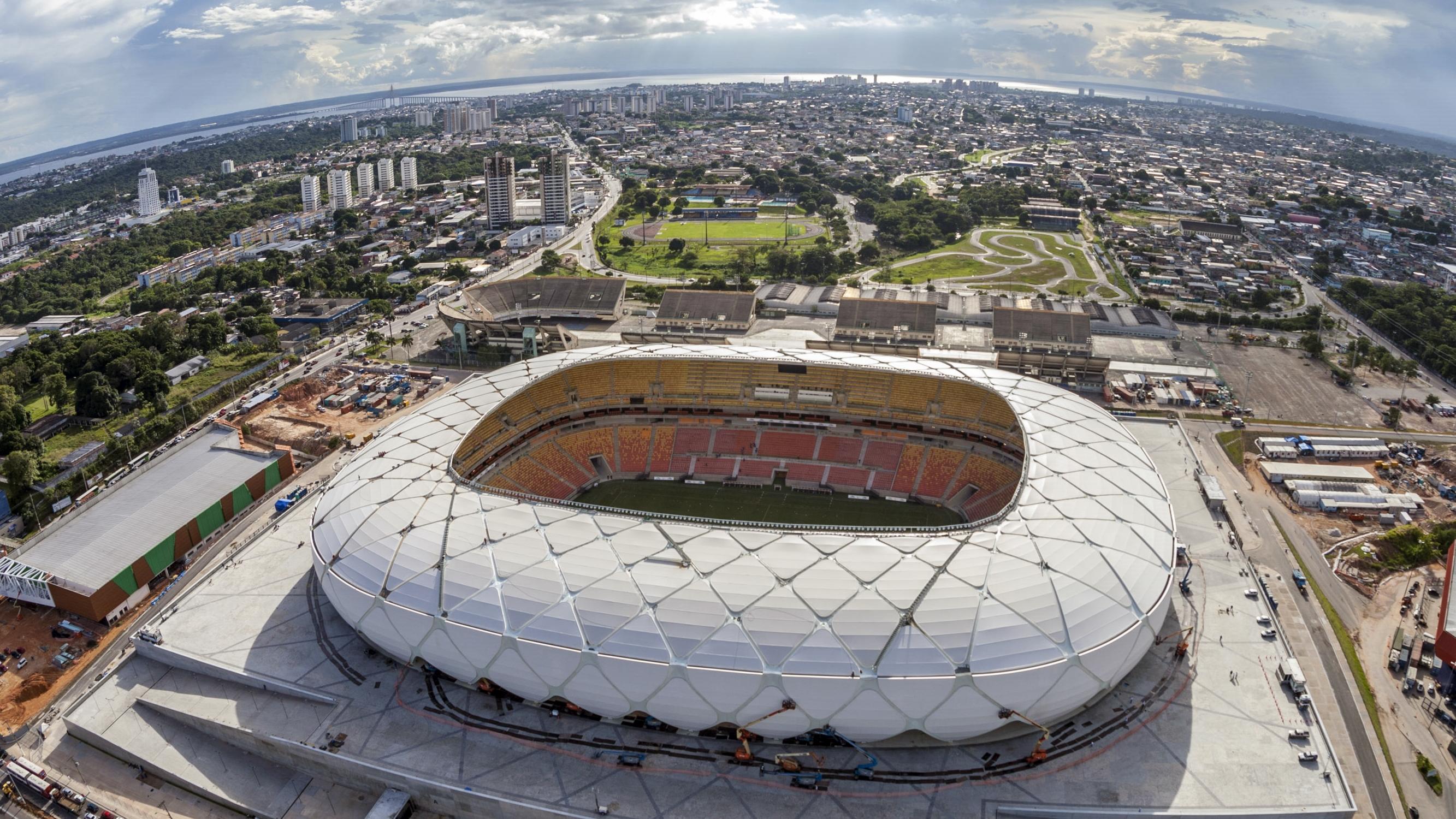
Located in Manaus, deep in the Amazon rainforest, Arena da Amazônia sits near the Rio Negro, one of the most important tributaries of the Amazon River. The stadium’s design takes inspiration from the indigenous culture and the natural environment, with a lattice structure resembling a woven basket. It’s a stunning example of sustainability, using rainwater collection and ventilation techniques to reduce energy consumption.
5. Fisht Olympic Stadium – Russia
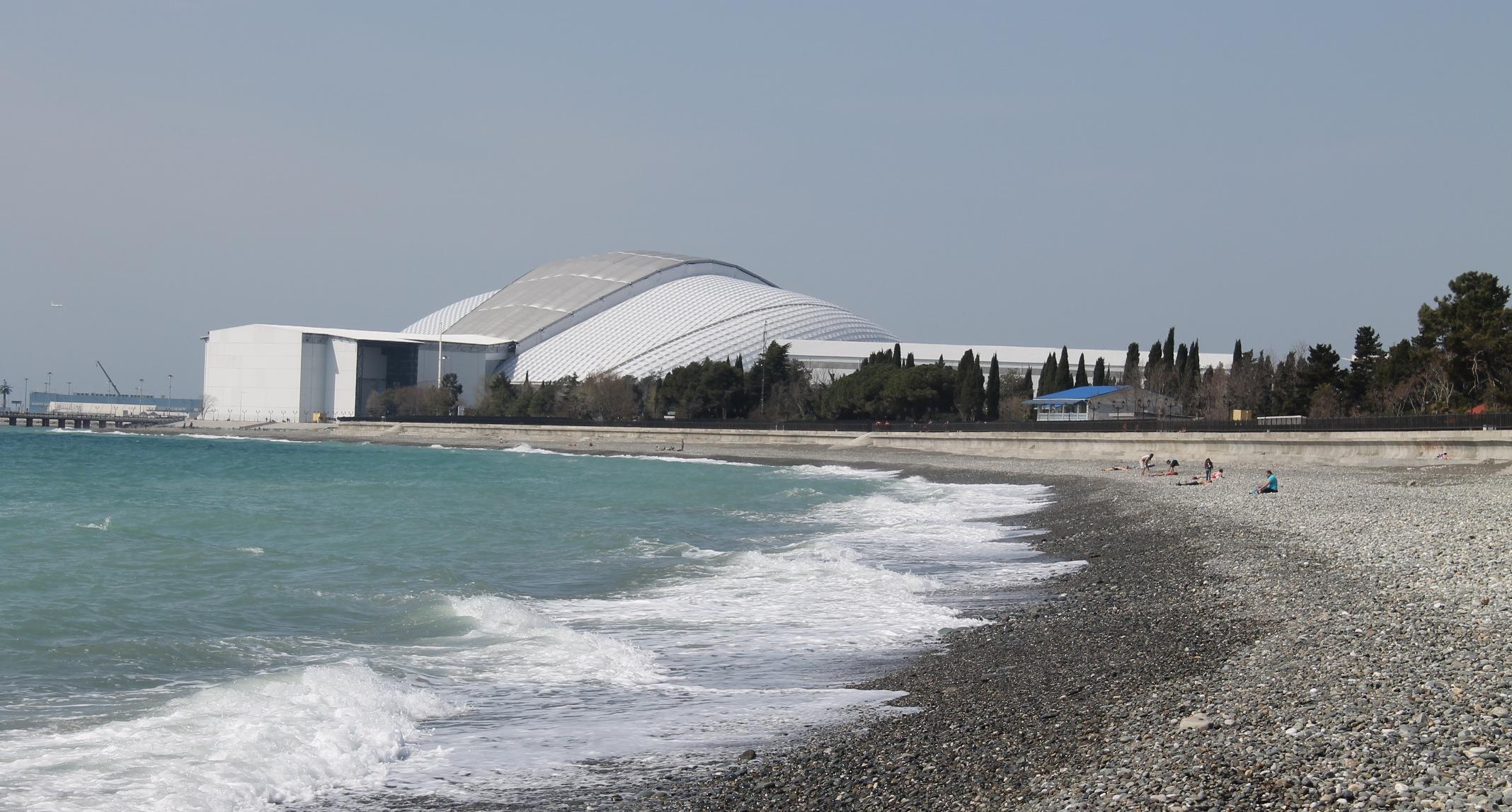
Originally built for the 2014 Winter Olympics, the Fisht Olympic Stadium in Sochi is one of the most beautifully situated stadiums in the world. Sitting on the edge of the Black Sea, with the towering Caucasus Mountains behind it, this stadium offers a stunning combination of coastal and alpine scenery. It has since hosted World Cup matches and international sporting events, cementing its place as a global sports hub.
6. Kantrida Stadium – Croatia
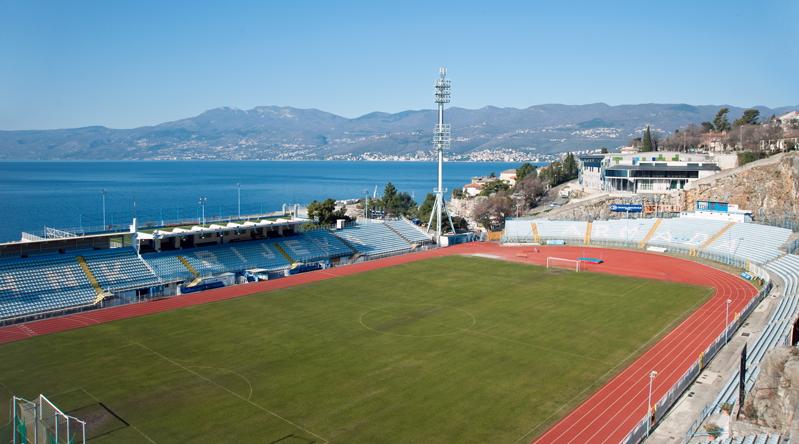
Kantrida Stadium in Rijeka, Croatia, is built into a cliffside overlooking the Adriatic Sea, making it one of the most breathtaking football stadiums in the world. Fans are treated to an incredible view of the turquoise waters while enjoying matches. Though a new stadium is being planned to replace it, Kantrida remains an iconic venue known for its dramatic setting.
7. Estádio Municipal de Braga – Portugal
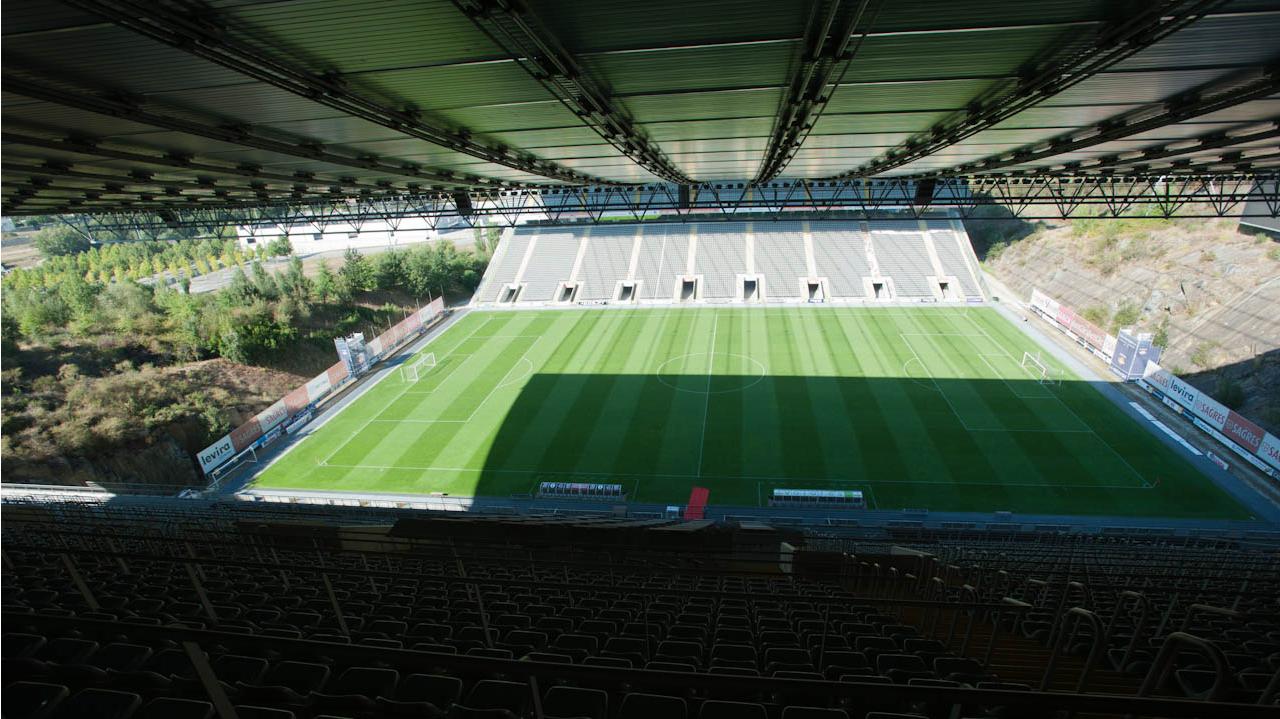
Portugal’s Estádio Municipal de Braga is a true architectural wonder. Built into the side of an old quarry, this stadium features two massive rock walls on either side, giving it an almost gladiatorial feel. The stadium overlooks the Cávado River, creating an open, airy experience for spectators while blending perfectly with the natural landscape.
8. Allegiant Stadium – USA
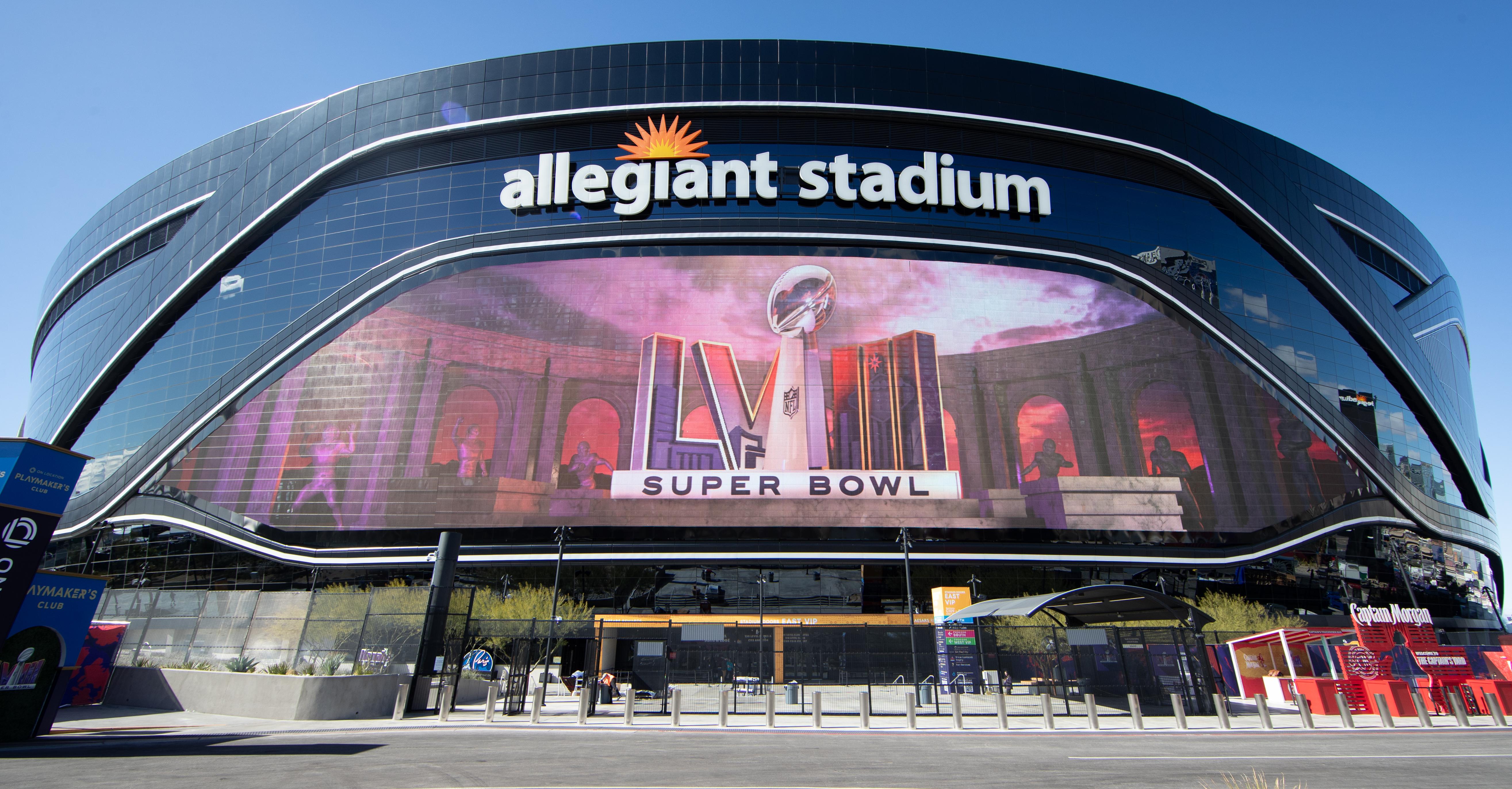
Home to the Las Vegas Raiders, Allegiant Stadium stands near the Colorado River, reflecting the city’s neon glow in its sleek, jet-black exterior. While not floating, its glass-heavy design allows fans to take in water views from within. The stadium is a marvel of modern architecture, featuring a retractable field and cutting-edge cooling systems to combat the desert heat.
9. Sapporo Dome – Japan
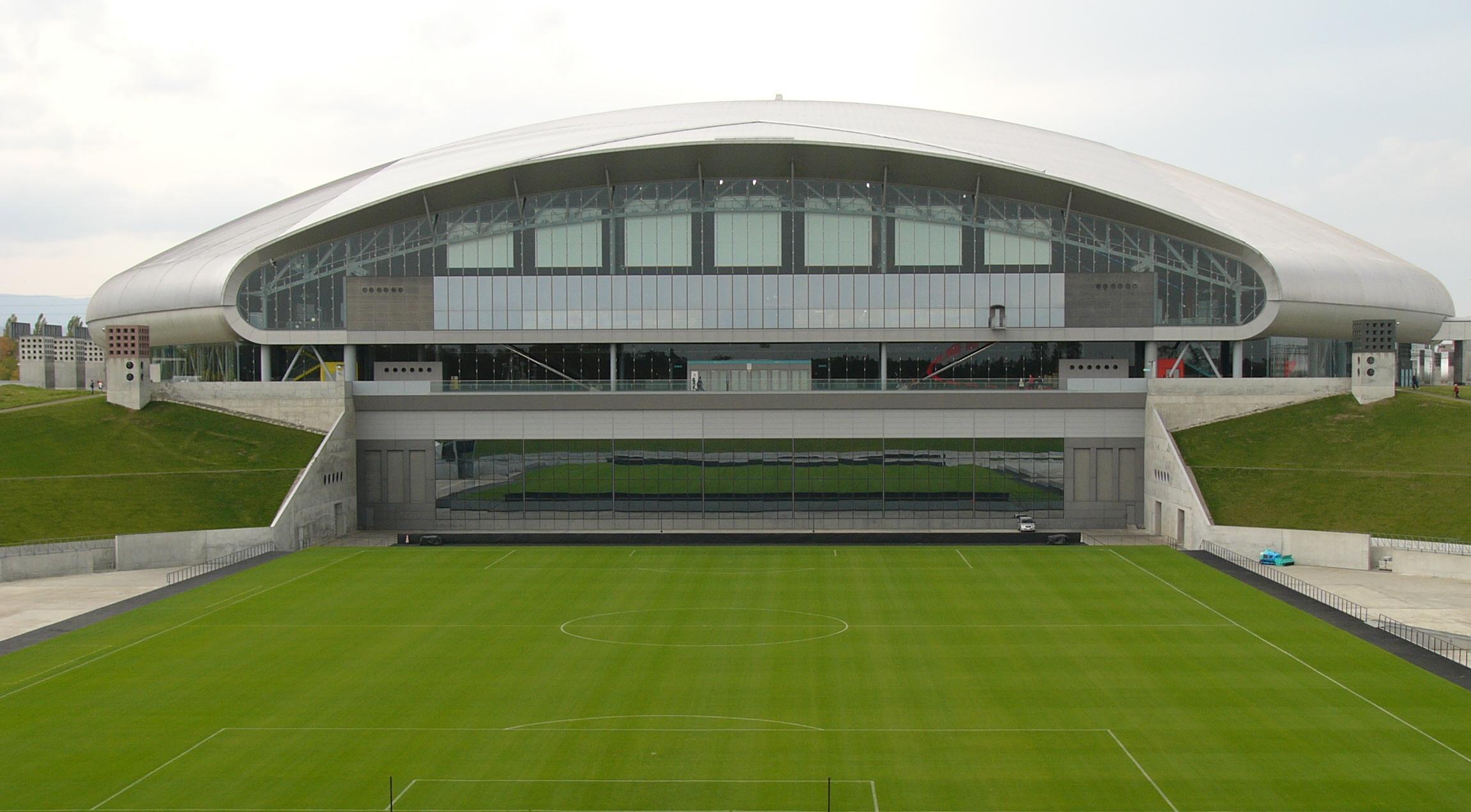
Japan’s Sapporo Dome, located on the island of Hokkaido, is one of the world’s most innovative stadiums. While it’s not on water, the snow-covered landscape and nearby Ishikari Bay make it feel like an icy fortress. The stadium has a moving pitch, allowing it to switch from baseball to football seamlessly. Its unique setting provides a surreal winter wonderland for sports fans.
10. Seeb Stadium – Oman
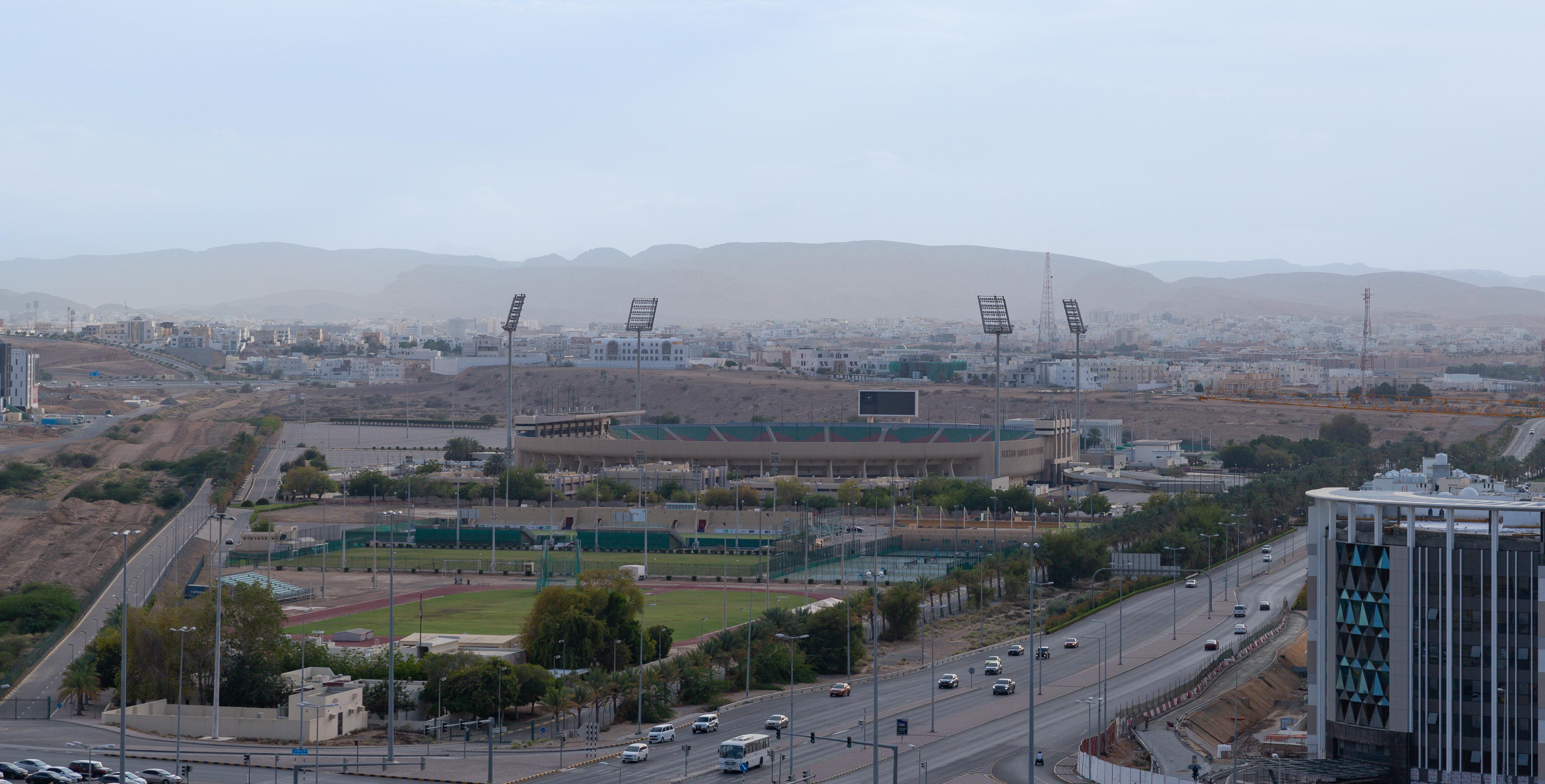
Oman’s Seeb Stadium, located in Muscat, offers a spectacular coastal backdrop along the Arabian Sea. With golden beaches just a stone’s throw away, the stadium provides fans with stunning ocean views and warm, breezy conditions. The natural beauty of the Omani coastline, combined with its passion for football, makes this a stadium like no other.
11. Stade de France – France
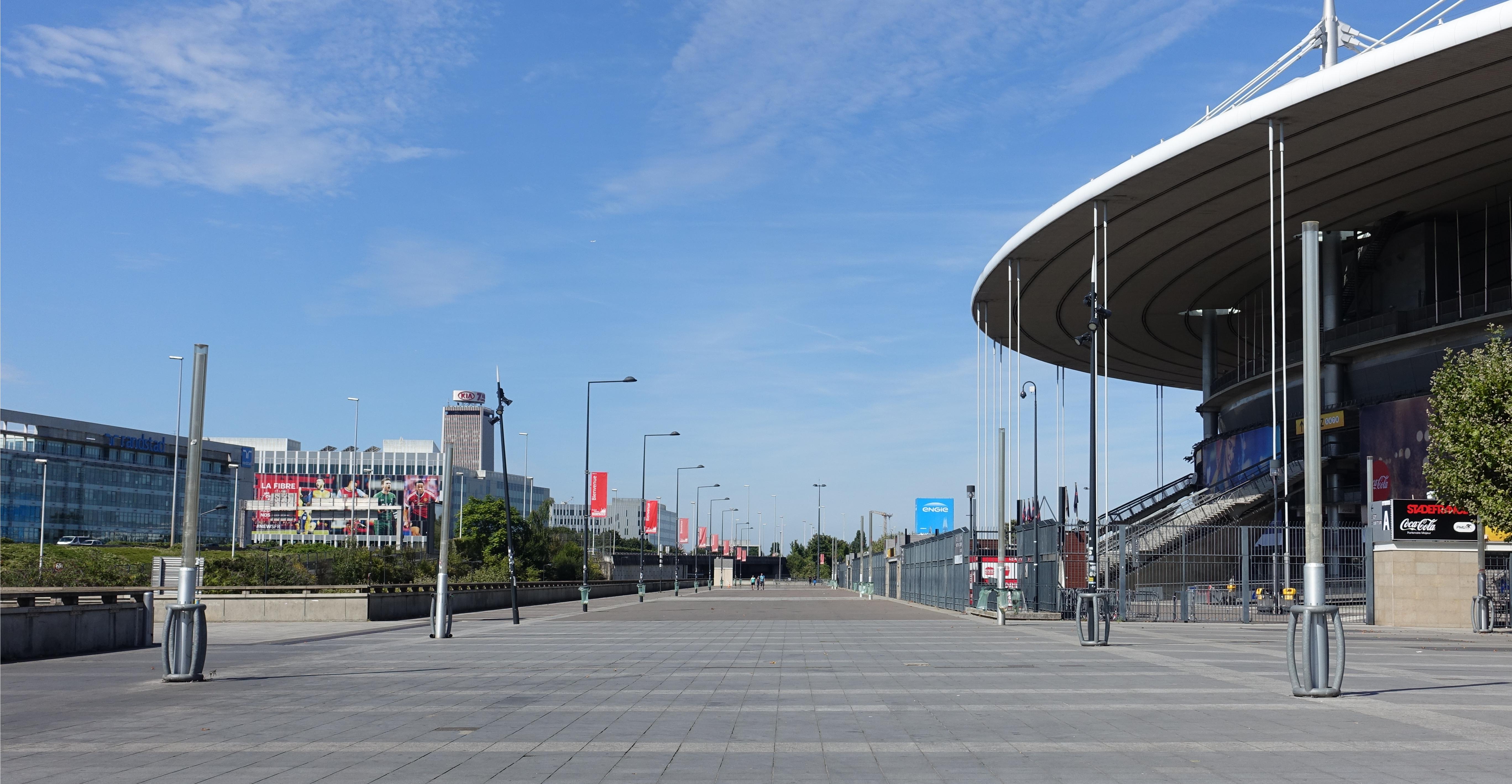
While not directly on the water, Stade de France sits beside the Seine River, offering an elegant Parisian backdrop. Built for the 1998 FIFA World Cup, it remains one of Europe’s most iconic stadiums, hosting international football, rugby, and concerts. The stadium’s location makes it easy for fans to arrive by boat, enhancing the game-day experience.
12. Cape Town Stadium – South Africa
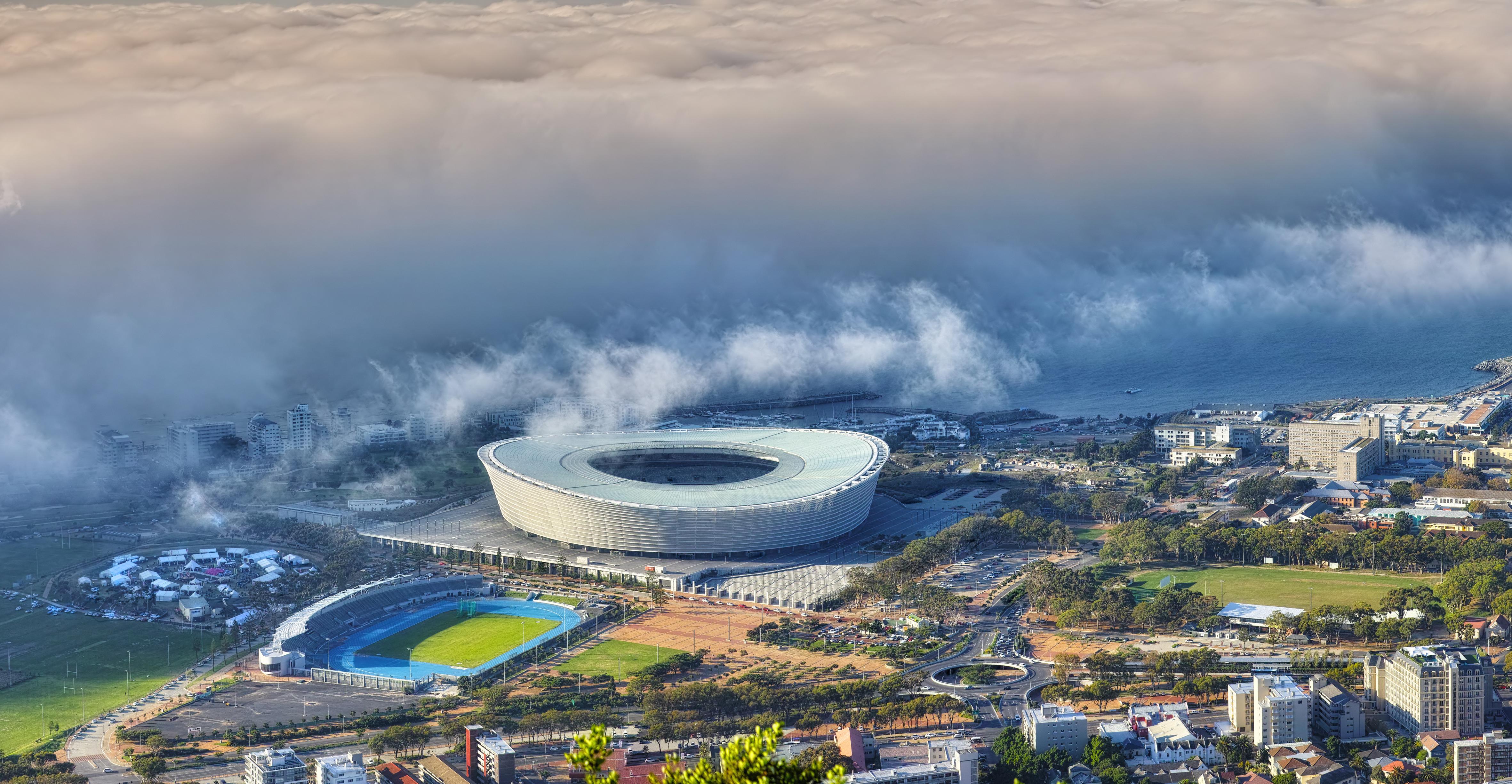
Few stadiums in the world boast a view as stunning as Cape Town Stadium in South Africa. Nestled between Table Mountain and the Atlantic Ocean, the stadium provides a breathtaking setting for sports and concerts alike. Built for the 2010 FIFA World Cup, it has since become a must-visit venue for both sports fans and tourists, offering scenic beauty alongside world-class events.
13. Stadium Tuanku Abdul Rahman – Seremban, Malaysia

Tucked within the lush hills of Negeri Sembilan, Malaysia, Stadium Tuanku Abdul Rahman offers a serene, subtropical twist on the waterfront stadium experience. Located near the scenic Lake Garden (Taman Tasik Seremban), the stadium benefits from cooling breezes and tranquil water views, especially during evening matches when the lights reflect softly on the nearby lake. As one of the country’s historic sporting venues, it has hosted major football tournaments and serves as the proud home of Negeri Sembilan FC. But beyond the roar of the crowd, what makes this stadium truly unique is how seamlessly it integrates into its natural surroundings. With jungle-draped hills in the backdrop and the lake nearby, it feels more like a tropical amphitheater than a concrete arena. A visit here is as much about soaking in the ambiance as it is watching the match unfold on the field.
14. Stade de l’Amitié Sino-Gabonaise – Libreville, Gabon
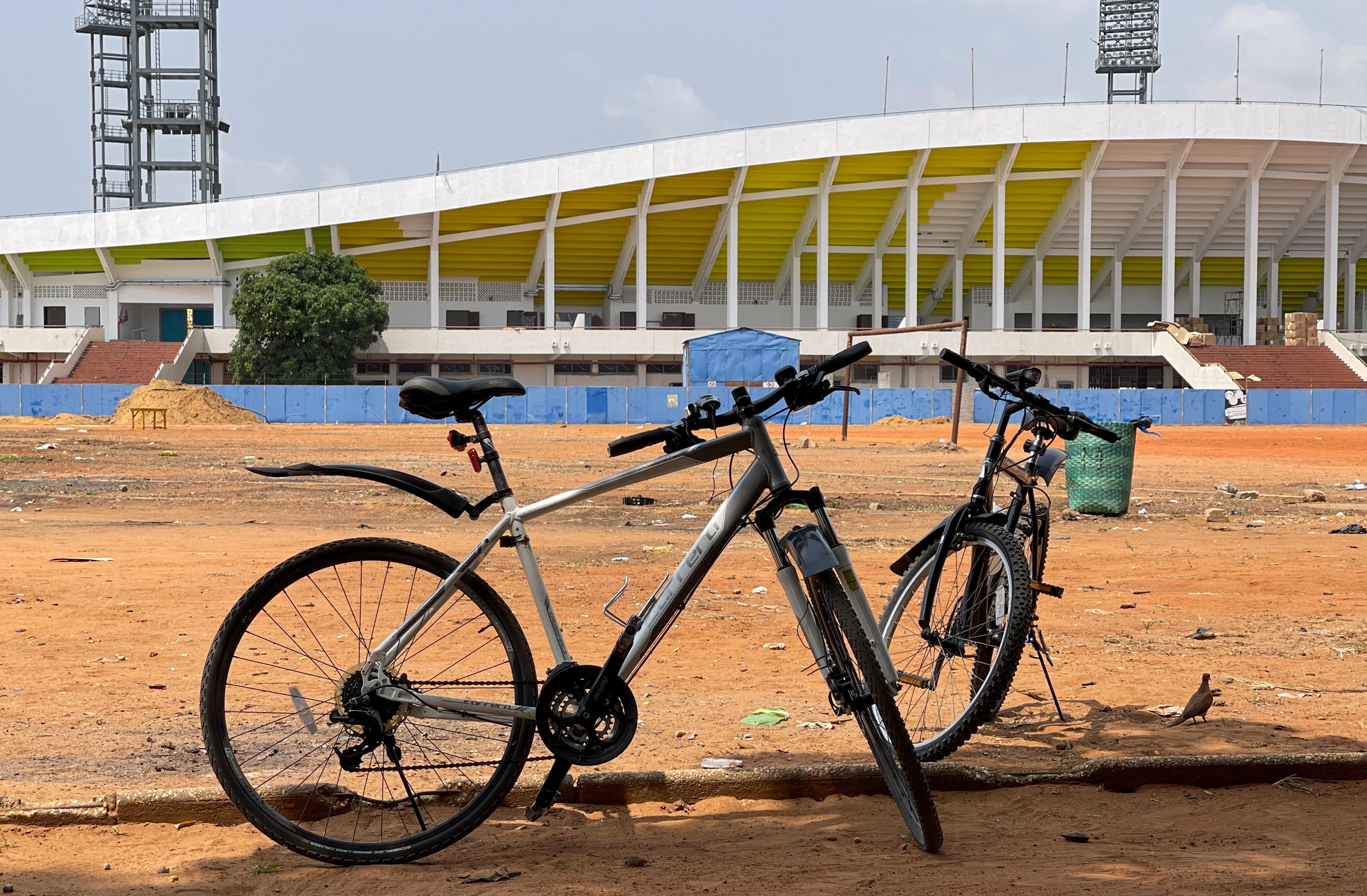
Situated just a short drive from the shimmering coastline of the Atlantic Ocean, Stade de l’Amitié Sino-Gabonaise is a striking example of modern stadium design set against a vibrant tropical backdrop. Built as a symbol of friendship between Gabon and China, this 40,000-seat stadium is one of the largest in Central Africa—and one of the most scenic. Though not perched directly on the shoreline, its location near Libreville’s palm-lined beaches allows sea breezes to sweep through during major events, adding to the immersive experience. The sleek, open-air structure is wrapped in contemporary design, while inside, it comes alive during international football tournaments and concerts. With its blend of cultural symbolism, coastal proximity, and architectural flair, Stade de l’Amitié doesn’t just host matches—it celebrates unity, progress, and the beauty of the Gabonese landscape.
15. Tele2 Arena – Stockholm, Sweden
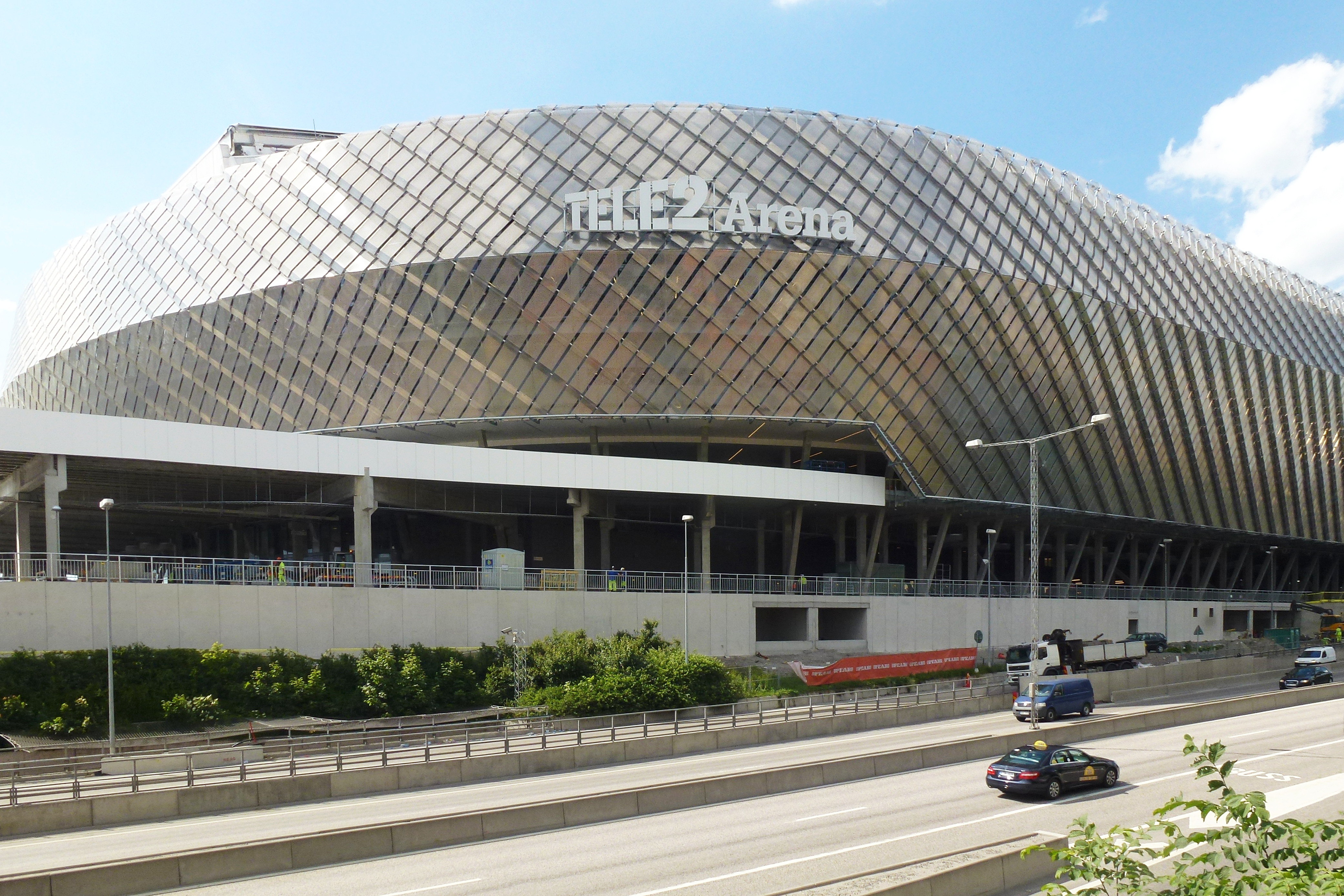
Located just minutes from the shimmering waters of Hammarby Lake, Tele2 Arena is a modern marvel that perfectly balances urban energy with serene waterfront proximity. This state-of-the-art, multi-purpose stadium is home to two of Stockholm’s biggest football clubs—Hammarby IF and Djurgårdens IF—and features a retractable roof, allowing year-round use in Sweden’s often unpredictable climate. While not floating or perched directly on the shoreline, the arena’s glass façade reflects the nearby waterways and city skyline, giving it a sleek, futuristic presence. Visitors can enjoy pre-game walks along the nearby canals or take in the sunset from local rooftop bars with views of the lake and arena. With its prime location in the heart of Stockholm and its connection to the surrounding waterfront neighborhoods, Tele2 Arena offers a stunning, accessible blend of sport, design, and Scandinavian charm.
16. Tehelné pole – Bratislava, Slovakia

Tehelné pole, nestled in Slovakia’s capital city of Bratislava, is a sleek, modern stadium located just a short distance from the tranquil waters of the Danube River. Rebuilt in 2019 on the site of its historic predecessor, this 22,500-seat venue is the proud home of ŠK Slovan Bratislava and the Slovak national football team. Though not directly on the riverbank, its proximity to the Danube adds a refreshing coastal charm to the match-day atmosphere. Surrounded by leafy parks and within walking distance of Bratislava’s scenic Old Town and riverside promenades, Tehelné pole blends top-tier sports facilities with the cultural richness of a Central European capital. With its sharp architecture, vibrant energy, and a backdrop that includes both city skyline and nearby waterways, the stadium offers a dynamic setting that elevates any sporting event.
17. Arena Pernambuco – Recife, Brazil
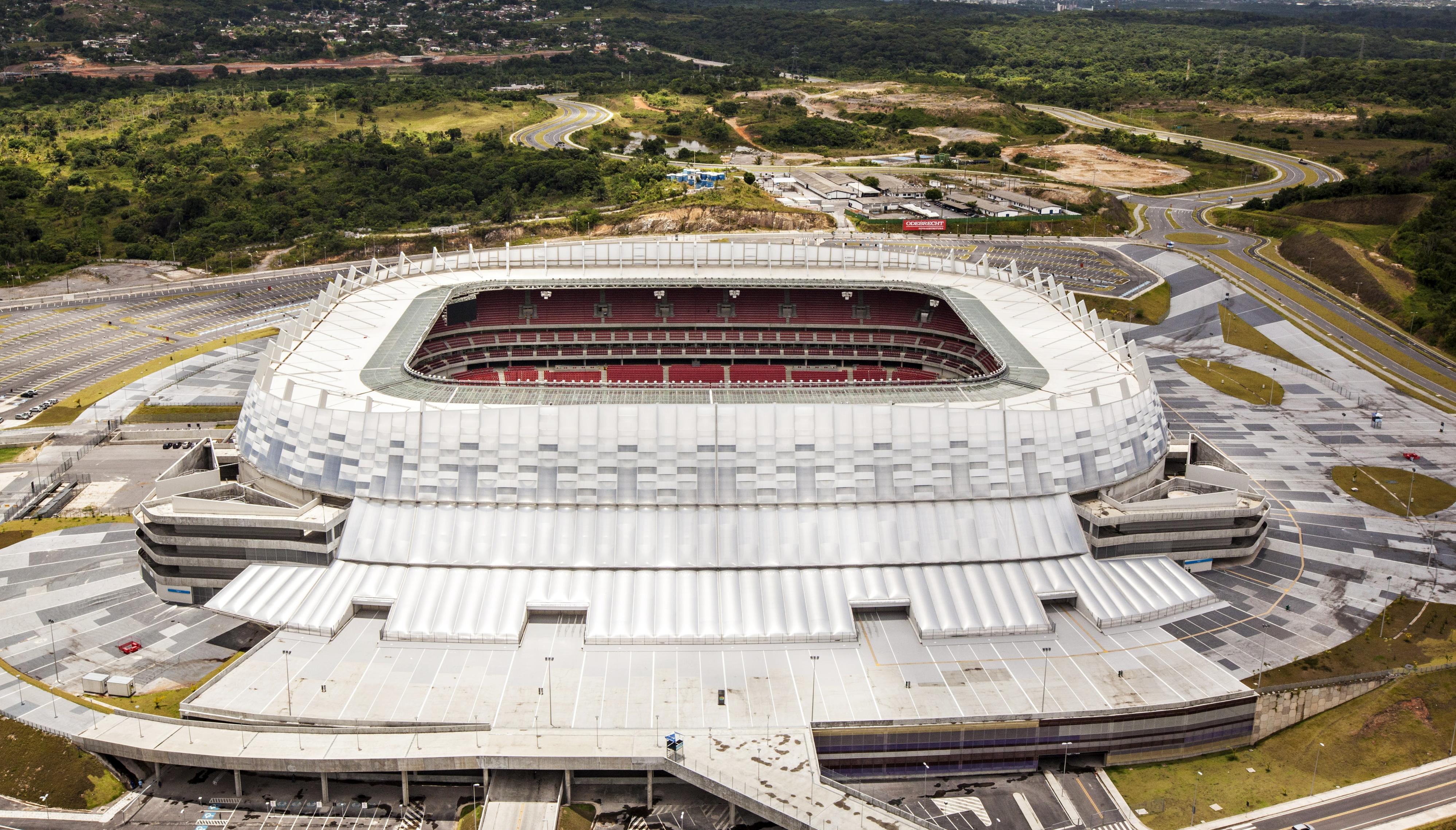
Located just west of the vibrant coastal city of Recife, Arena Pernambuco is a modern architectural gem that merges sport with sustainability. While not perched directly on the beach, the stadium is part of a larger urban development that sits near the Capibaribe River and benefits from the lush, tropical scenery of northeastern Brazil. Built for the 2014 FIFA World Cup, this 46,000-seat venue features sleek lines and open-air design that invites in the region’s balmy breezes. What sets it apart is its eco-conscious infrastructure, including a solar power plant that helps offset the stadium's energy consumption. With Recife’s famed beaches, lagoons, and mangroves just a short drive away, Arena Pernambuco offers a unique blend of world-class football and the vibrant rhythms of Brazil’s Atlantic coast. It’s a stadium where modern innovation meets natural beauty, providing an unforgettable match-day experience.
18. Accor Stadium – Sydney, Australia
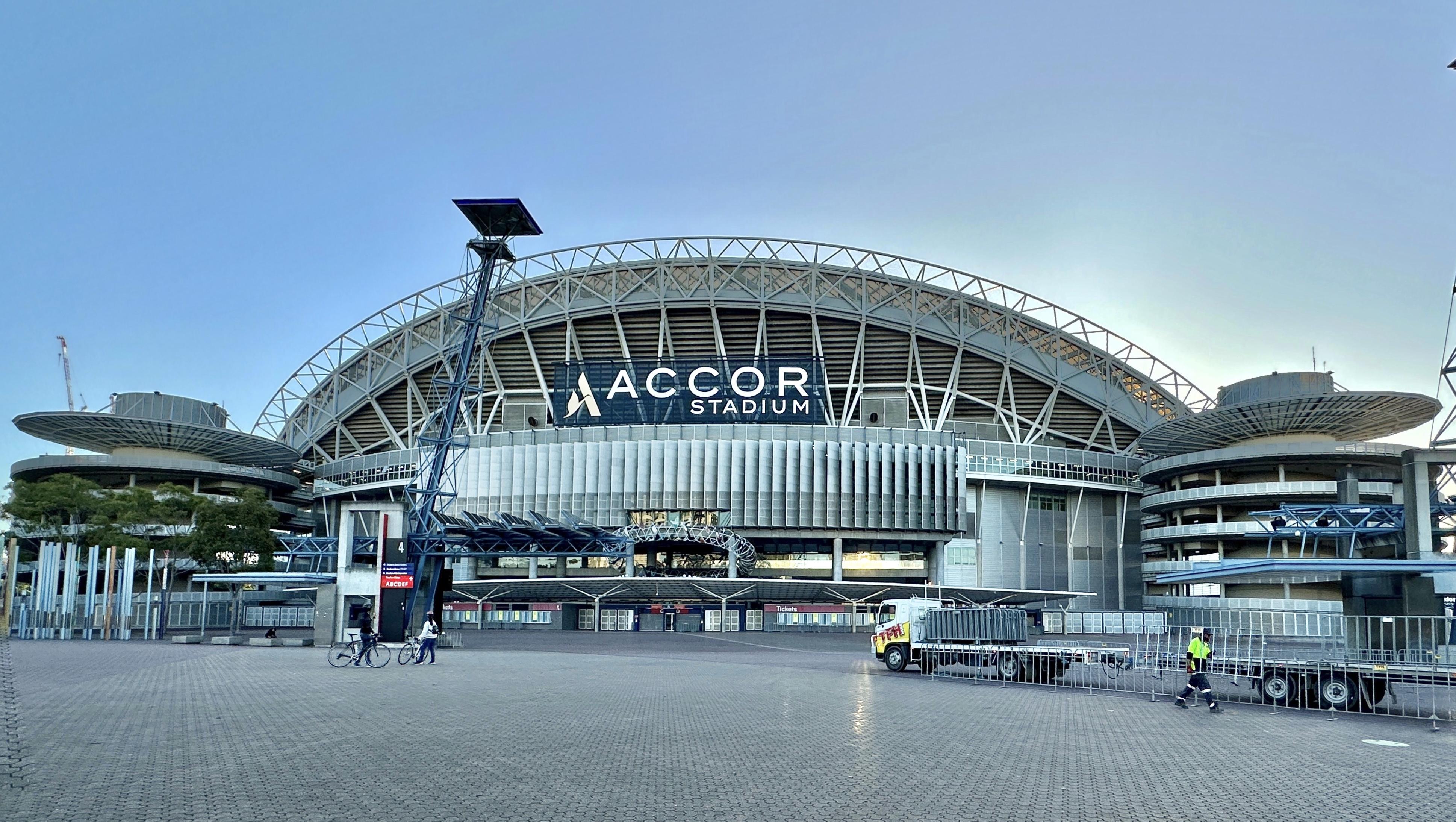
Set within Sydney Olympic Park and just minutes from the banks of the Parramatta River, Accor Stadium (formerly ANZ Stadium) blends world-class sports with waterfront serenity. Originally constructed for the 2000 Summer Olympics, this colossal multi-purpose venue can host up to 83,500 spectators, making it one of the largest stadiums in the Southern Hemisphere. While not directly on the coastline, its proximity to Bicentennial Park's lakes, wetlands, and river trails offers a striking natural contrast to its sleek, modern structure. The stadium’s open, elliptical design allows sea breezes to flow through, adding to the coastal atmosphere. Accor Stadium has witnessed some of Australia's most iconic sporting and entertainment moments—from Rugby World Cup matches to sold-out concerts—while sitting on the edge of a rejuvenated urban oasis. It’s where the energy of the city meets the calm of the waterfront, delivering unforgettable experiences in an unforgettable setting.
19. Kaliningrad Stadium – Kaliningrad, Russia
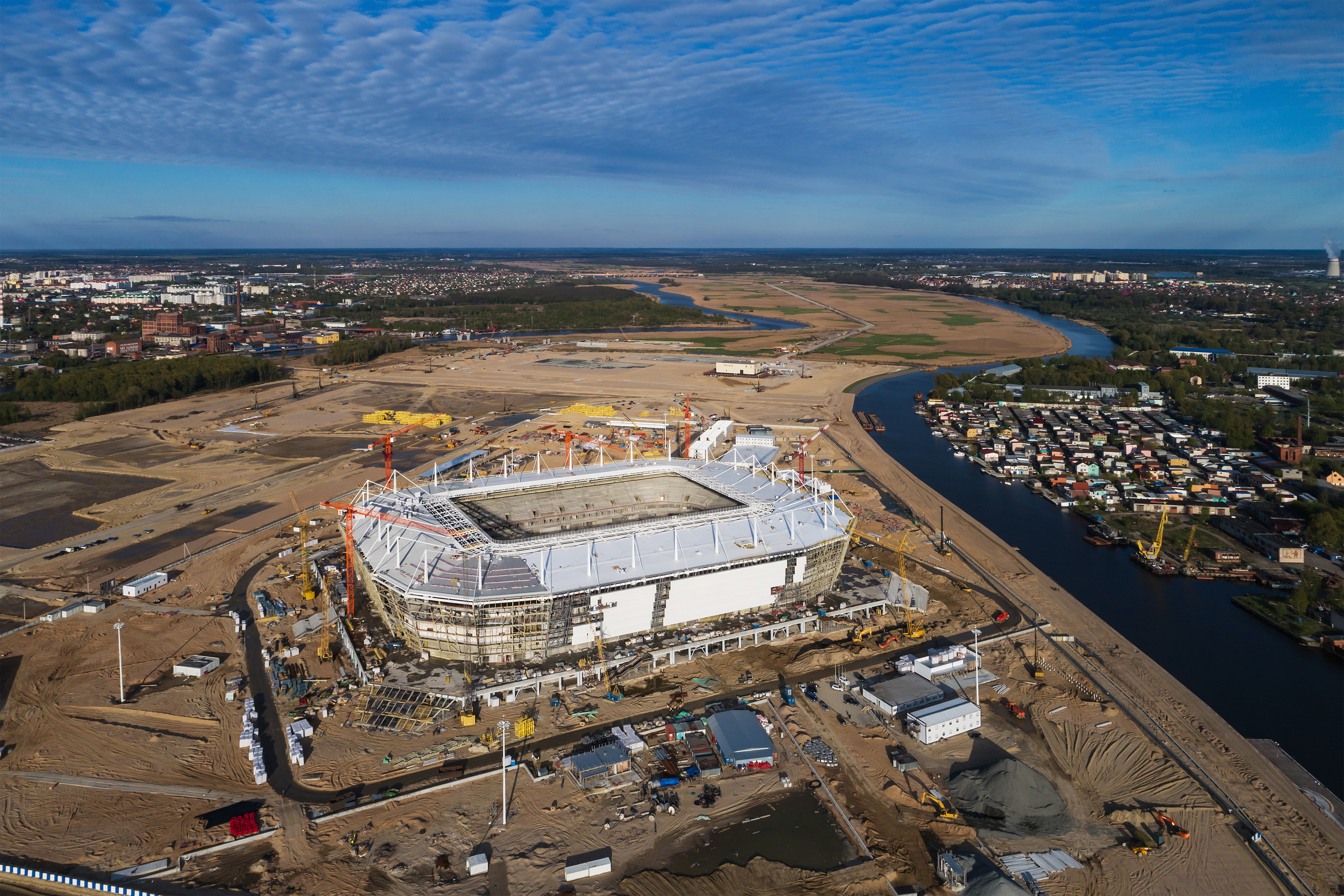
Perched on Oktyabrsky Island and surrounded by the Pregolya River, Kaliningrad Stadium is a striking example of modern architecture nestled in a historic and watery landscape. Built for the 2018 FIFA World Cup, this 35,000-seat arena was inspired by Munich’s Allianz Arena, featuring a glowing rectangular design that reflects beautifully on the nearby waterways. Though it’s located in Russia’s westernmost exclave, the stadium feels more like a European coastal venue, blending steel, glass, and wide open skies. On game days, the water shimmers under stadium lights, creating a magical atmosphere that feels both intimate and expansive. Its island setting gives fans the rare experience of crossing bridges and walking river paths to reach their seats—making Kaliningrad Stadium not just a sports venue, but a scenic destination.
20. Thuwunna Stadium – Yangon, Myanmar
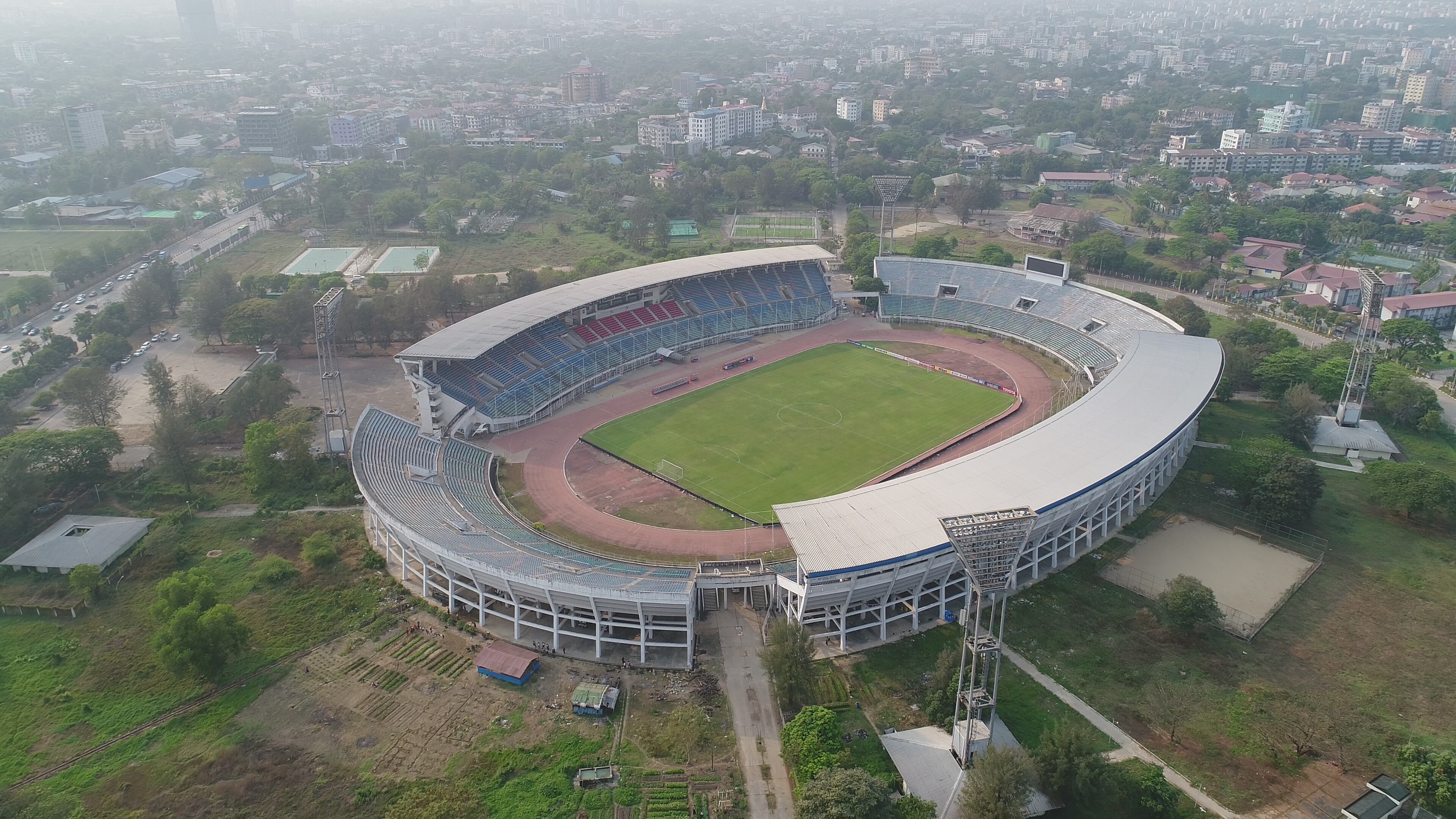
Located near Kandawgyi Lake in the heart of Yangon, Thuwunna Stadium is a tranquil yet commanding presence in Myanmar’s sporting landscape. Often referred to as Thuwunna Youth Training Centre Stadium, this multi-purpose venue is surrounded by lush greenery and lies just a short walk from the calm, lotus-dotted waters of the lake. Originally built in the 1980s and later renovated to meet international standards, the stadium offers seating for around 32,000 spectators and serves as a key venue for national football matches and athletics events. What makes it stand out is its peaceful, almost park-like surroundings—a rare contrast to the energy and noise of competition inside. The reflection of the stands in nearby water at sunset gives Thuwunna a poetic serenity, making it not just a place to cheer, but to appreciate the balance between nature and sport.
21. Moses Mabhida Stadium – Durban, South Africa
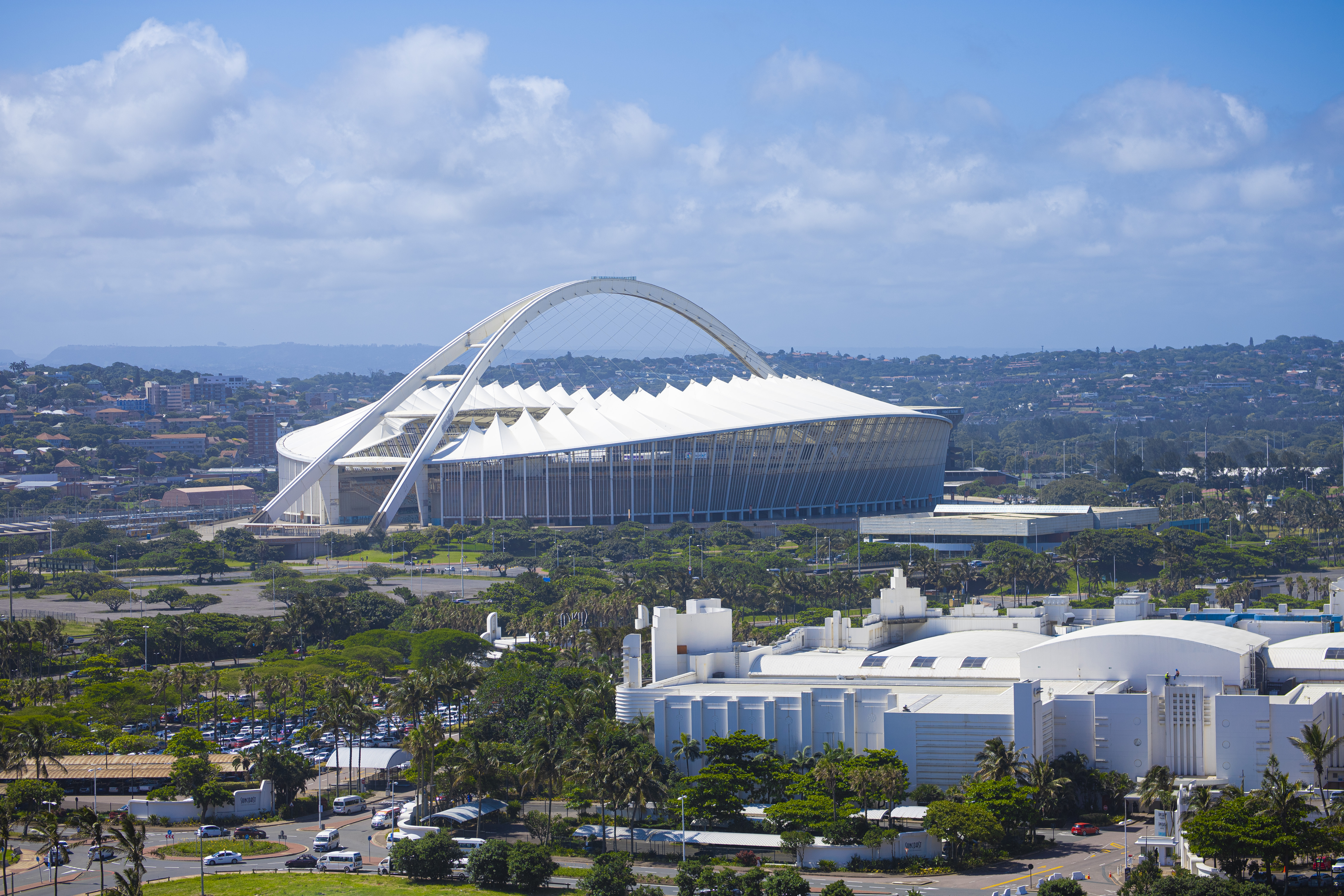
Set against the sparkling coastline of the Indian Ocean, Moses Mabhida Stadium in Durban is a stunning architectural gem that blends bold design with breathtaking views. Built for the 2010 FIFA World Cup, the stadium is instantly recognizable by its iconic arch, which stretches 350 meters across the roof and offers a unique “SkyCar” ride to a panoramic viewing platform. Just minutes from the beach, the stadium sits within the lush Kings Park Sporting Precinct and enjoys a refreshing ocean breeze year-round. Its open, wave-inspired design mirrors the nearby shoreline, creating a seamless flow between land and sea. Beyond football, the venue hosts concerts, cricket matches, and even adventure sports like bungee swings from the arch. With the Indian Ocean as its backdrop and the city’s golden beaches just steps away, Moses Mabhida isn’t just a stadium—it’s a destination.
22. Tofiq Bahramov Stadium – Baku, Azerbaijan
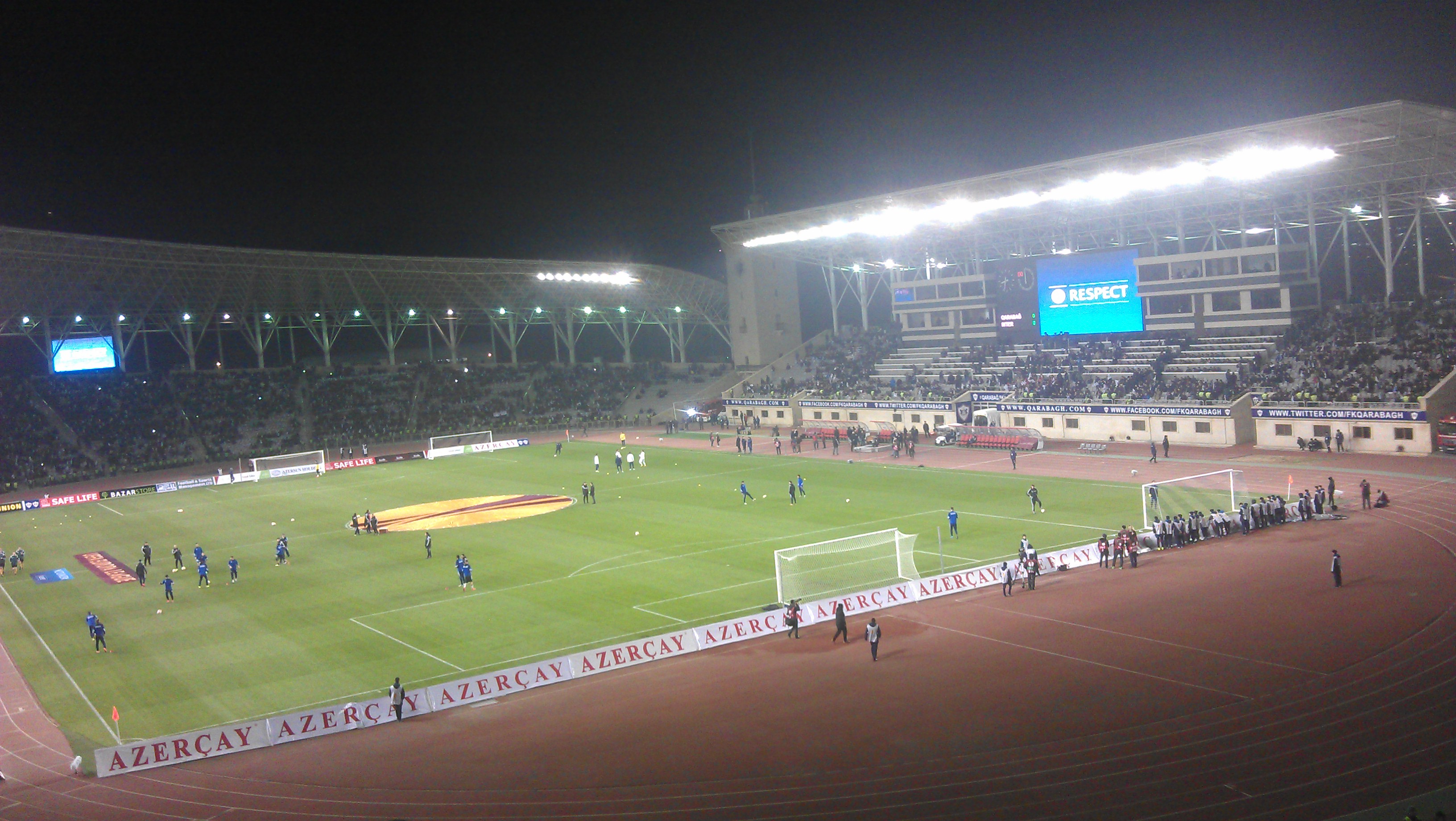
Nestled in the heart of Baku with views stretching toward the Caspian Sea, Tofiq Bahramov Stadium combines sporting history with coastal charm. Originally built in the 1950s and later named after the legendary Azerbaijani referee, this stadium is steeped in local and international football lore. While not directly on the waterfront, its proximity to the Caspian coastline gives it a breezy, open feel, and its position within the city offers glimpses of the sea from the upper stands. The stadium has hosted countless memorable matches, including UEFA fixtures and national events, making it a central piece of Azerbaijan’s sporting identity. Surrounded by modern development and seaside promenades, Tofiq Bahramov offers a unique blend of nostalgia, architecture, and the fresh energy of Baku’s ever-evolving skyline.
Where Sports and Scenery Collide
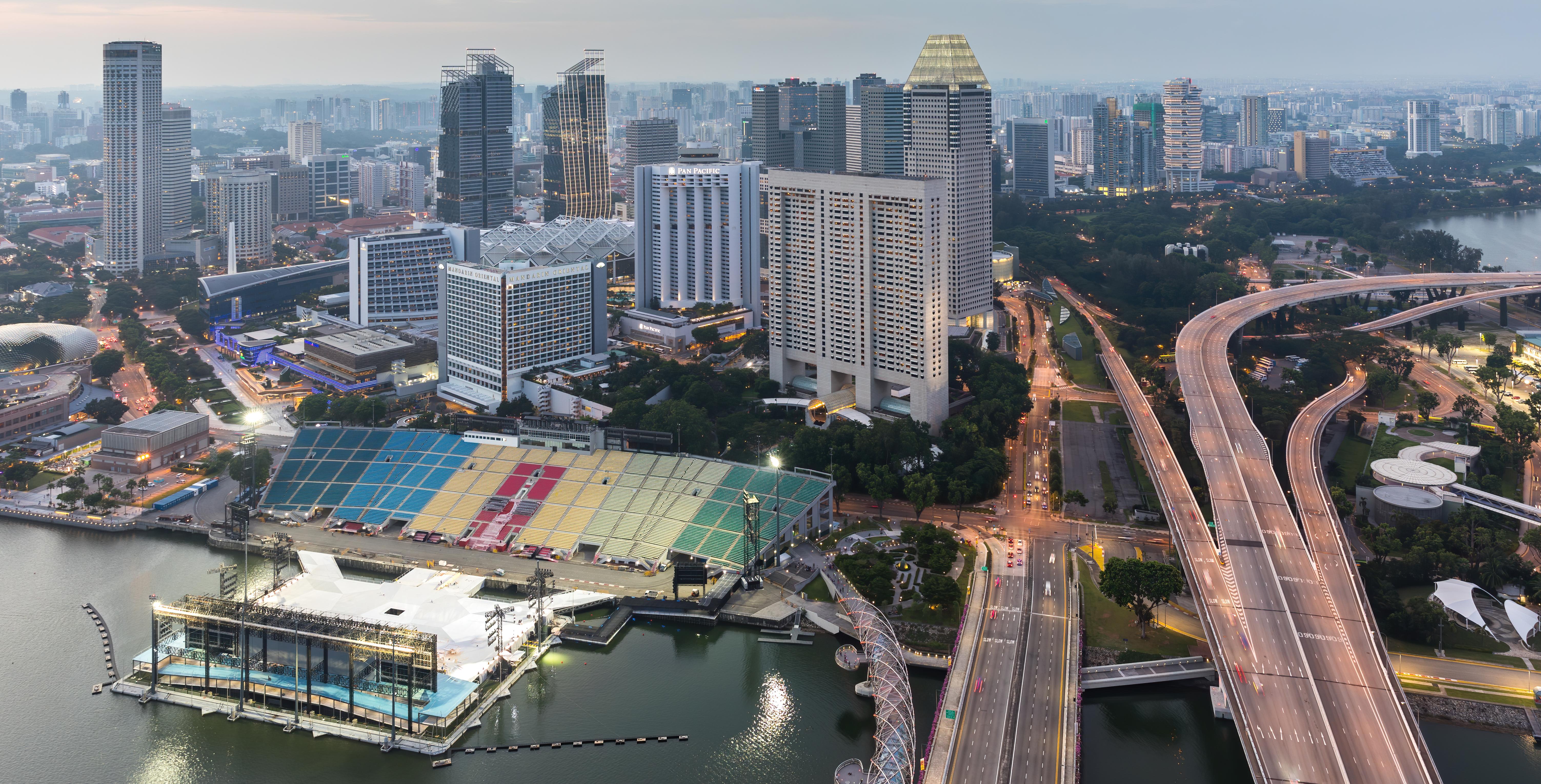
These 22 waterfront stadiums prove that sports venues can be more than just arenas—they can be works of art, blending seamlessly with their surroundings to create an unforgettable experience. Whether floating on a bay, carved into cliffs, or overlooking the sea, these stadiums offer breathtaking views and thrilling sporting moments. If you’re a sports fan or a lover of incredible architecture, these stadiums belong on your bucket list. Which of these waterfront stadiums would you love to visit first? Let us know!








